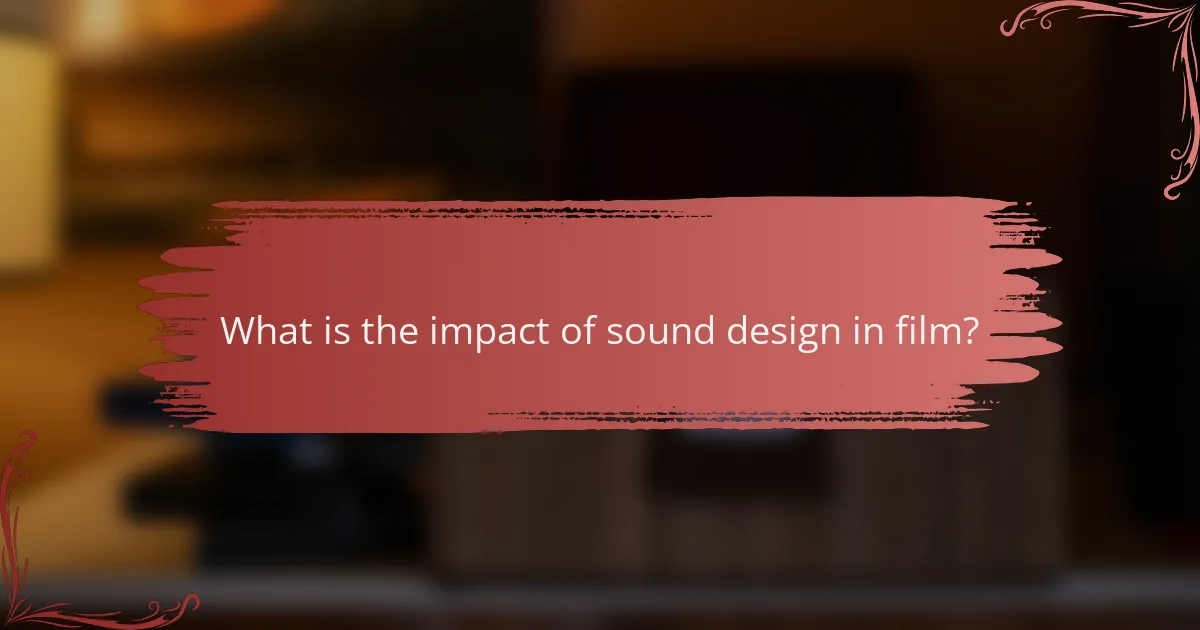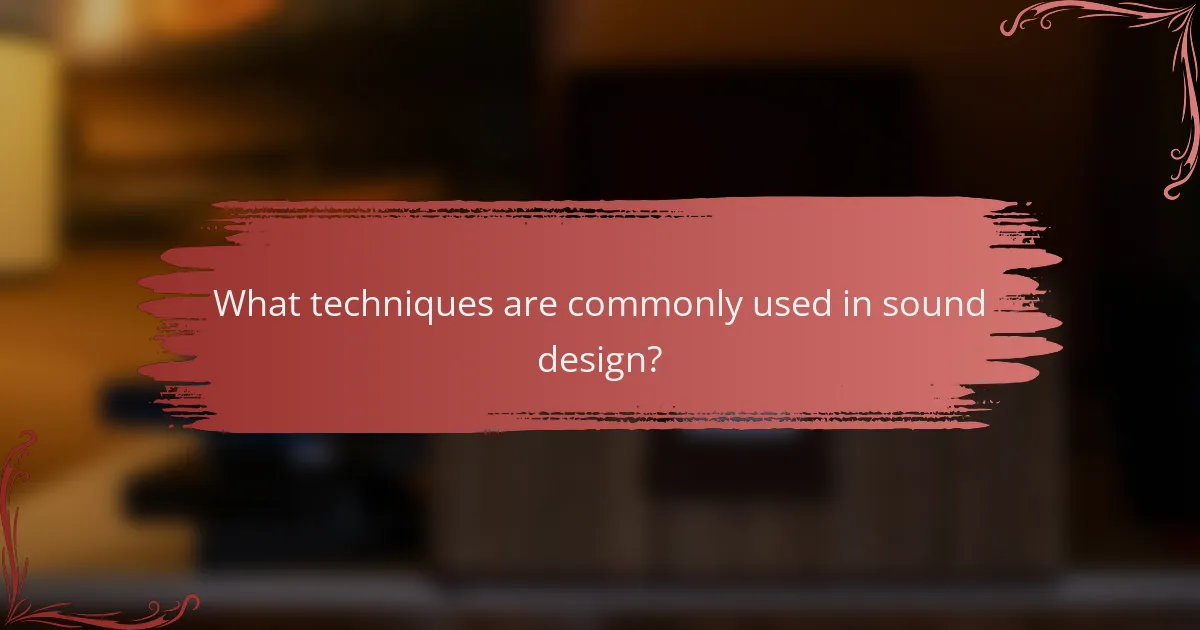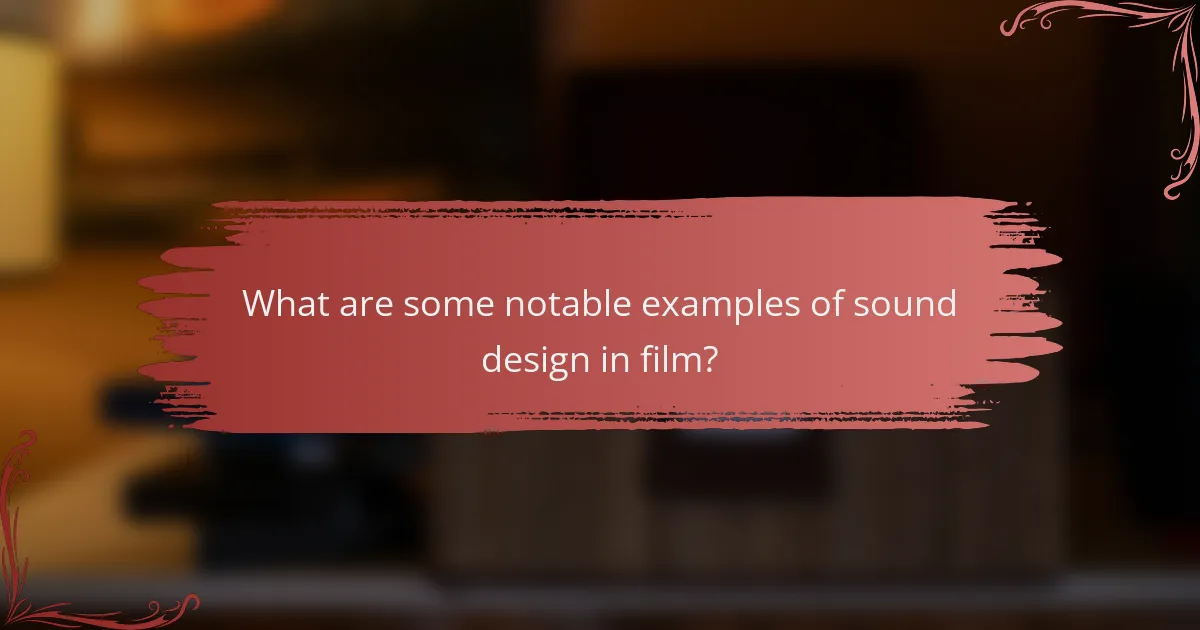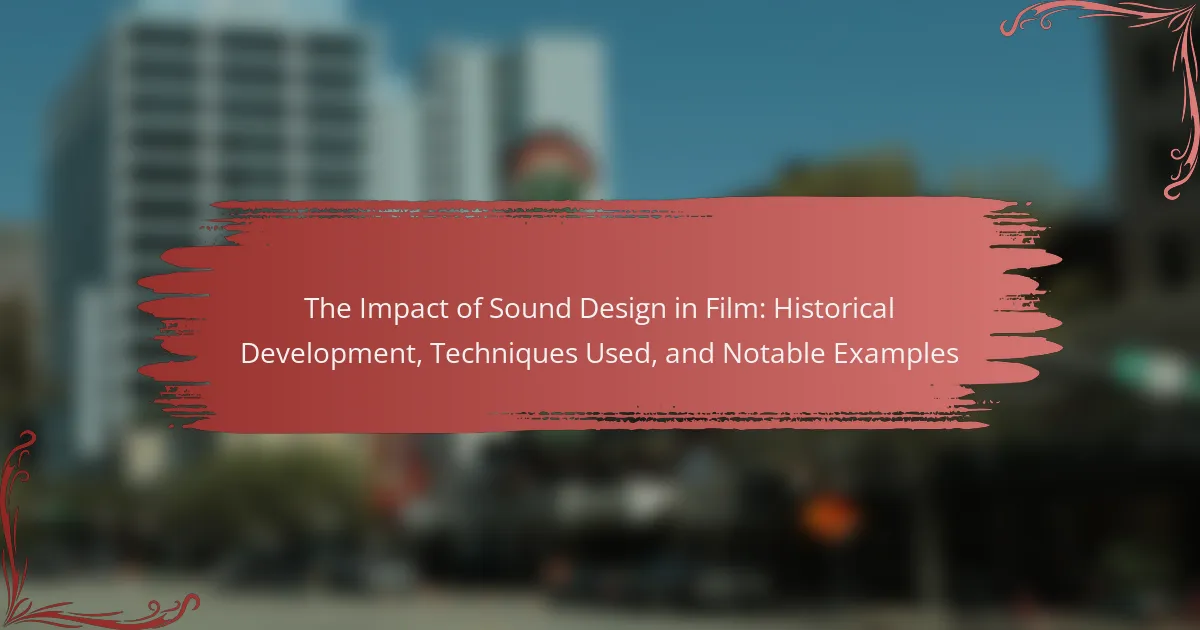Sound design is a crucial element in filmmaking that enhances emotional and narrative depth. It encompasses dialogue, sound effects, and music, all of which shape audience perception and experience. Key techniques include layering, field recording, and Foley, each contributing to the overall soundscape and storytelling. Notable films such as “Star Wars,” “Inception,” and “A Quiet Place” exemplify the significant impact of sound design on audience engagement and emotional response, demonstrating its importance in the film industry. This article explores the historical development of sound design, the techniques employed, and notable examples that highlight its effectiveness in enhancing cinematic experiences.

What is the impact of sound design in film?
Sound design significantly enhances the emotional and narrative depth of a film. It shapes the audience’s perception and experience. Effective sound design creates atmosphere and supports storytelling. It includes dialogue, sound effects, and music. Each element contributes to the overall impact. For instance, a suspenseful score can heighten tension. Conversely, ambient sounds can immerse viewers in a setting. Studies show that sound influences emotional responses. Research indicates that well-crafted sound can improve audience engagement by up to 30%. This underscores the importance of sound design in filmmaking.
How has sound design evolved throughout film history?
Sound design has evolved significantly throughout film history. Initially, films were silent, relying solely on visuals and live music. The introduction of synchronized sound in the late 1920s marked a revolutionary change. “The Jazz Singer,” released in 1927, was the first feature film with synchronized dialogue. This transition allowed for more expressive storytelling.
In the 1930s and 1940s, sound design expanded to include sound effects and ambient sound. Techniques such as Foley, developed in this era, enhanced realism. By the 1950s, stereo sound systems began to emerge, providing a more immersive experience. The use of surround sound was popularized in the 1970s with films like “Star Wars.”
Digital sound technology emerged in the 1990s, allowing for precise editing and manipulation. This led to the creation of complex soundscapes in modern films. Today, sound design is integral to filmmaking, influencing audience emotions and engagement. The evolution of sound design reflects advancements in technology and artistry throughout film history.
What were the early techniques used in sound design?
Early techniques used in sound design included Foley, location sound recording, and sound layering. Foley involved creating everyday sound effects in sync with film to enhance realism. This technique was pioneered in the 1920s by sound artist Jack Foley. Location sound recording captured ambient sounds directly from the filming environment. It provided authenticity to the audio experience. Sound layering combined multiple sound elements to create a rich auditory landscape. This technique became essential for building atmosphere in films. These foundational methods significantly shaped the evolution of sound design in cinema.
How did technological advancements shape sound design practices?
Technological advancements significantly transformed sound design practices in film. Innovations such as multi-track recording allowed for the layering of sounds. This enabled sound designers to create rich, complex audio landscapes. The introduction of digital audio workstations revolutionized editing and mixing efficiency. Tools like Pro Tools became industry standards for sound editing. Furthermore, advancements in sound libraries provided access to high-quality sound effects. The development of surround sound technology enhanced the immersive experience for audiences. These changes collectively elevated the quality and creativity of sound design in film.
Why is sound design crucial to the filmmaking process?
Sound design is crucial to the filmmaking process because it enhances storytelling and emotional engagement. Effective sound design creates an immersive experience for the audience. It supports the narrative by providing auditory cues that guide viewer perception. Sound can establish mood and atmosphere, influencing how scenes are interpreted. For instance, the use of silence can amplify tension, while music can evoke specific emotions. According to a study by the University of Southern California, sound design significantly impacts audience retention and emotional response. This demonstrates that sound is not merely an accessory but a fundamental aspect of filmmaking.
What role does sound design play in storytelling?
Sound design plays a crucial role in storytelling by enhancing the emotional and narrative depth of a film. It creates an immersive experience for the audience, allowing them to connect more deeply with the story. Sound design includes dialogue, sound effects, and music, all of which contribute to the overall atmosphere. For example, a suspenseful score can heighten tension in a thriller. Additionally, sound effects can provide context and realism, such as the sound of footsteps in a quiet scene. Historical examples include the use of sound in films like “Star Wars,” where innovative sound design helped define characters and settings. Research shows that sound can influence audience perception and emotional response, making it a vital element in effective storytelling.
How does sound design enhance the emotional experience of a film?
Sound design enhances the emotional experience of a film by creating an immersive auditory environment. It uses elements like dialogue, sound effects, and music to evoke specific feelings. For example, suspenseful music can heighten tension during critical scenes. Conversely, soft melodies can evoke nostalgia or sadness. Research indicates that sound can influence viewer perception and emotional response significantly. According to a study published in the Journal of Experimental Psychology, sound effects can alter how viewers interpret visual information. This demonstrates that sound design is crucial in shaping emotional engagement in film.

What techniques are commonly used in sound design?
Common techniques used in sound design include layering, field recording, and Foley. Layering involves combining multiple sound elements to create a richer auditory experience. Field recording captures sounds from real environments to add authenticity. Foley is the reproduction of everyday sound effects that are added to films in post-production. These techniques enhance storytelling and emotional impact in film. For instance, layering can create a sense of depth in a scene. Field recordings can immerse the audience in a specific location. Foley adds realism by syncing sounds to on-screen actions. Each technique plays a crucial role in crafting the overall soundscape.
How do sound designers create a soundscape for a film?
Sound designers create a soundscape for a film by layering various audio elements. They begin with recording or sourcing sounds relevant to the film’s setting. This includes dialogue, ambient sounds, and sound effects. Sound designers then manipulate these sounds using software to enhance their quality. They adjust pitch, volume, and timing to fit the film’s narrative. Additionally, they may incorporate music to evoke emotions. The final soundscape is mixed to ensure balance and clarity. This process contributes significantly to the film’s overall atmosphere and storytelling.
What are the different types of sound elements used in film?
The different types of sound elements used in film include dialogue, sound effects, and music. Dialogue refers to the spoken words between characters. It drives the narrative and helps convey emotions. Sound effects are artificial or enhanced sounds added to create realism or evoke specific reactions. They can include everything from footsteps to explosions. Music sets the tone and mood of a scene. It can underscore emotions or provide thematic continuity. Additionally, ambient sound is used to create a sense of space and environment. Each of these elements contributes significantly to the overall impact of a film.
How do Foley artists contribute to sound design?
Foley artists enhance sound design by creating custom sound effects that synchronize with visual elements. They use various props and techniques to replicate everyday sounds. These sounds include footsteps, rustling clothes, and ambient noises. Foley recordings are essential for immersing audiences in the film’s environment. The process involves capturing sounds in a studio to match the on-screen action precisely. This attention to detail improves the overall audio experience of the film. High-quality Foley work can significantly elevate a film’s emotional impact. Historical examples show that effective Foley contributes to the realism and believability of cinematic storytelling.
What tools and software are essential for sound design?
Essential tools and software for sound design include digital audio workstations (DAWs), synthesizers, and audio plugins. Popular DAWs like Pro Tools, Ableton Live, and Logic Pro X are widely used in the industry. These platforms allow sound designers to record, edit, and mix audio efficiently. Synthesizers such as Serum and Massive provide sound creation capabilities. Audio plugins like Waves and iZotope offer effects and processing tools. These tools enhance creativity and streamline workflows. According to the Journal of the Audio Engineering Society, the right software can significantly impact sound quality and design efficiency.
What are the most popular digital audio workstations (DAWs) used in the industry?
The most popular digital audio workstations (DAWs) used in the industry include Ableton Live, Pro Tools, Logic Pro, and FL Studio. Ableton Live is favored for its intuitive interface and live performance capabilities. Pro Tools is considered the industry standard for audio editing and mixing. Logic Pro is well-known for its comprehensive suite of tools for music production. FL Studio is popular among electronic music producers for its user-friendly workflow. These DAWs are widely adopted in professional studios and by independent artists alike.
How do sound libraries and plugins assist sound designers?
Sound libraries and plugins assist sound designers by providing a wide range of pre-recorded audio samples and virtual instruments. These resources save time by eliminating the need to create sounds from scratch. Sound libraries offer diverse sounds, including ambient effects, musical instruments, and sound effects. Plugins enhance audio manipulation capabilities, allowing for effects like reverb, compression, and equalization.
Using these tools, sound designers can achieve professional-quality results more efficiently. For instance, libraries may contain thousands of sounds, accessible with a few clicks. Plugins can simulate real-world acoustics, adding depth and realism to soundscapes. This combination of resources enables sound designers to focus on creativity and storytelling in their projects.

What are some notable examples of sound design in film?
Notable examples of sound design in film include “Star Wars,” “Inception,” and “A Quiet Place.” “Star Wars” features iconic sound effects like the lightsaber and TIE fighter sounds, crafted by Ben Burtt. “Inception” employs a unique score by Hans Zimmer, integrating sound design with music to enhance tension. “A Quiet Place” uses silence and subtle sounds to create suspense, emphasizing the film’s theme of sound as a survival element. Each of these films demonstrates how sound design can significantly impact storytelling and audience experience.
Which films are recognized for their innovative sound design?
Films recognized for their innovative sound design include “Star Wars,” “Inception,” and “A Quiet Place.” “Star Wars,” released in 1977, introduced groundbreaking techniques like the use of synthesized sounds. “Inception,” released in 2010, utilized a unique soundscape to enhance its complex narrative. “A Quiet Place,” released in 2018, creatively employed silence and sound to build tension. These films have received critical acclaim for their contributions to the art of sound design.
What specific techniques were employed in these films?
Films employed various sound design techniques to enhance storytelling. These techniques include diegetic and non-diegetic sound. Diegetic sound originates from the film’s world, such as dialogue or ambient noise. Non-diegetic sound includes background scores or voiceovers that exist outside the film’s narrative.
Foley artistry is another technique, involving the creation of sound effects in post-production to match the visual elements. Additionally, sound layering is used to combine multiple audio tracks for a richer auditory experience. Surround sound technology enhances immersion by placing sounds in a three-dimensional space.
These techniques collectively contribute to the emotional impact and realism of films. For instance, the use of silence can heighten tension, while music can evoke specific feelings. Historical examples include the innovative sound design in “Star Wars,” which utilized unique sound effects and music to create an iconic auditory landscape.
How did these films influence the field of sound design?
These films revolutionized the field of sound design by introducing innovative techniques and technologies. They showcased the importance of sound as a narrative device. For instance, “Star Wars” utilized groundbreaking audio effects, establishing a new standard for sound in cinema. The film’s use of layered soundscapes created immersive experiences for audiences. Similarly, “Apocalypse Now” incorporated environmental sounds to enhance emotional depth. This film’s unique approach to sound design influenced future filmmakers to prioritize audio in storytelling. The techniques developed in these films are now foundational in modern sound design practices.
What lessons can be learned from successful sound design examples?
Successful sound design examples teach the importance of creating an emotional connection with the audience. Effective sound design enhances storytelling by reinforcing themes and character emotions. For instance, the use of silence in “A Quiet Place” amplifies tension and fear. Layering sounds can create a rich auditory experience, as seen in “Blade Runner 2049.” Attention to detail in sound effects makes scenes more immersive. The integration of diegetic and non-diegetic sounds can guide viewer perception. Collaboration between sound designers and directors is crucial for achieving a unified vision. These lessons highlight sound design’s role in elevating film narratives.
How can aspiring sound designers apply these lessons to their work?
Aspiring sound designers can apply lessons from historical sound design by studying techniques used in notable films. They should analyze how sound enhances storytelling and emotional impact. For instance, the use of ambient sound in “Apocalypse Now” created a sense of place and atmosphere. Understanding the role of Foley in films like “Star Wars” can improve their sound effects skills. They should also experiment with layering sounds to create depth, as seen in “Inception.” Learning from these examples enables sound designers to develop their unique style and approach.
What best practices should sound designers follow?
Sound designers should follow several best practices to ensure high-quality audio production. First, they must maintain a clear understanding of the project’s vision and goals. This alignment helps in creating sound that enhances the narrative. Second, sound designers should prioritize organization during the sound design process. Properly labeling and categorizing audio files streamlines workflow and collaboration. Third, they should utilize high-quality recording equipment. Quality tools capture clearer sound, reducing the need for extensive post-production fixes. Fourth, sound designers must pay attention to the emotional impact of sound. Each sound element should contribute to the audience’s emotional experience. Fifth, collaboration with other departments is essential. Regular communication with directors, editors, and composers ensures cohesive sound design. Finally, sound designers should always seek feedback. Constructive criticism helps improve their work and refine their skills. Following these practices leads to effective sound design that significantly enhances film production.
The main entity of this article is sound design in film, which plays a crucial role in enhancing emotional and narrative depth. The article explores the historical development of sound design, tracing its evolution from silent films to modern digital techniques. Key topics include the techniques used in sound design, such as Foley and sound layering, the impact of technological advancements, and notable examples of films recognized for their innovative sound design. Additionally, it covers best practices for aspiring sound designers and highlights the importance of sound in storytelling and audience engagement.
